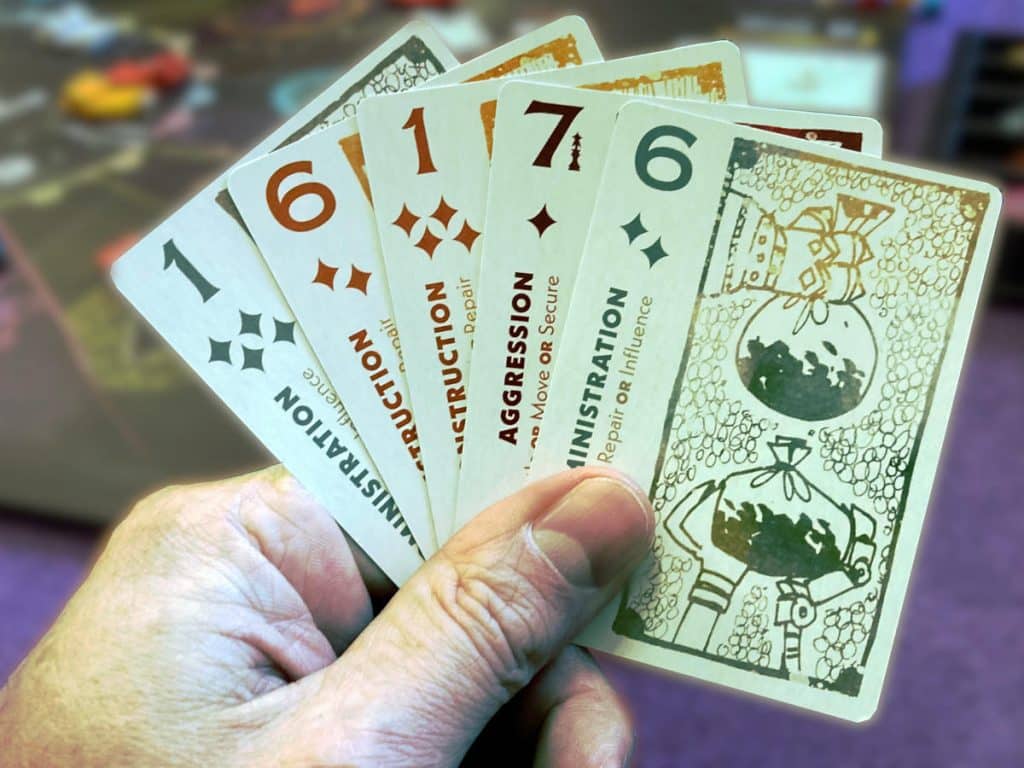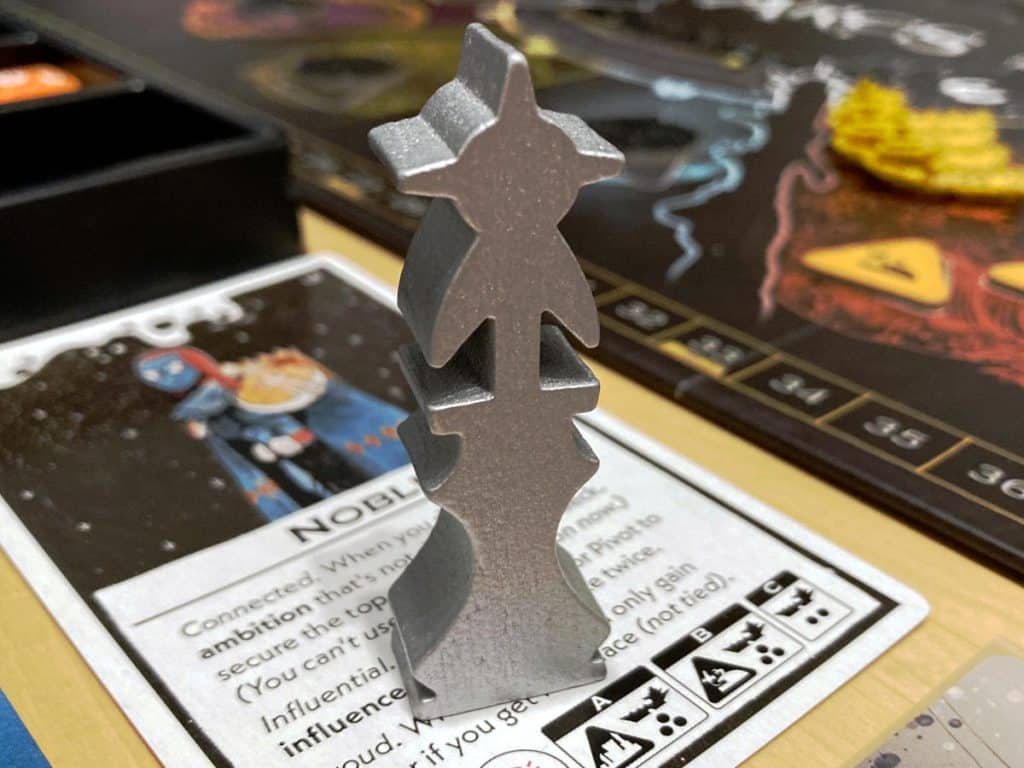| Release Date: 2024 | Players: 2-4 |
| Designer: Cole Wehrle | Length: 90-120 minutes |
| Artist: Kyle Ferrin | Age: 12+ |
| Publisher: Leder Games | Complexity: 3.5 / 5 |
| Plastic (by weight): unknown | Air (by volume): unknown |
The spacefaring cultures were moving their forces through the gates and across the systems, changing the control in the clusters in the Reach. The balance of the court was also no longer guaranteed. Agents were making their influence known and securing their positions. It didn’t take long for the first battles to start, damaging cities and spaceports and leading to captives and trophies. Maneuvering was getting almost impossible and the only way to move fleets was in Arcs by Cole Wehrle from Leder Games.
Listen to the Audio Version
Intro Music: Bomber (Sting) by Riot (https://www.
Music I Use: Bensound.com/royalty-free-music
License code: M5MHW6VMTFT1QKBS
Sports News 2 by Sascha Ende
Free download: https://filmmusic.
License (CC BY 4.0): https://filmmusic.
The Best That Is Arcs
Continuing in the long line of four-letter-named games, Arcs is the latest in Leder Games‘ line-up. As a game designed by Cole Wehrle, whose previous works include Root and Oath, you know roughly what to expect: a mix of many different mechanisms that combine into a game that gives players difficult, but interesting choices and that requires the formation of temporary alliances with the goal of total dominance, all of which have to be timed to perfection to be most effective.
Arcs is a weird combination of action point economy, derived from the trick-taking part of the game, area majority and resource management as ways of scoring victory points, dice rolling for battle resolution, hand management and a good pinch of negotiation thrown in. That makes the game a hard-to-describe beast of an experience. It is also what creates a fair amount of complexity in the game.
Allow me to describe Arcs by starting with the game’s core mechanism: trick-taking. That is already a bit of a misnomer. While you do have a deck of cards that come in four different suits and are numbered 1 to 7 and there is a lead player who decides the lead suit, there are a few differences to traditional trick-taking games. First of all, whoever wins the trick doesn’t score any points, but they do become the lead player in the next round. Secondly, there is no requirement to follow suit, but doing so can give you more action points. Finally, you don’t play a whole trick and then resolve it at the end. Instead, everyone plays their card and immediately takes their turn. The trick-taking is just there to decide how many action points and what type players have available.

Trick-Taking in Arcs
High-value cards allow you to keep the lead, but also offer fewer action points. So sometimes you intentionally play a lower card as the lead player, giving you more things to do on your turn, even though someone else will likely become lead player in the next round. However, if you’re a good trick-taking player, you can sometimes play your hand in such a way that you keep the lead and still get to play lower-value cards that give you more actions.
Also, with Arcs being a card-driven game in many ways, your best-laid plans may not always work out. If the hand you’re dealt doesn’t give you the actions you need, it can feel frustrating. Yet, not everything is lost. You can either change plans and pivot or you can rely on the other players’ cards. After all, if you don’t have the cards you wanted, chances are other players will. So if you allow someone else to take the lead, you can follow their action and still get to do what you planned, be it at a smaller scale. As someone who copies the lead action, you will have only one action point to use. Yet, that’s still better than not being able to do anything useful at all.
Now while I wouldn’t say Arcs is a trick-taking game, it does still have a lot of trick-taking vibes. You can apply many tricks and concepts from traditional trick-taking games to this game to gain an advantage. That’s one reason why I enjoy the game so much. It’s one facet of Arcs that I feel I have under control. It’s a familiar part that makes the game easier to play for me, but it can also be the part that creates frustration for people, if they’re not trick-taking players.
The Complexity of Arcs
Apart from trick-taking, there is a lot more to Arcs of course. In fact, the rules complexity is relatively high, even though the game is actually pretty simple to play. While in theory there are a lot of things people could potentially do on their turn, players’ choices are narrowed down by the cards that are being played. A lot of the depth in Arcs comes from the card play. While everyone will have a rough strategy, ultimately everyone is just reacting to what others are doing.
Players also need to decide whether they stop someone else from scoring or focus on their own point potential. I would say that negotiating with other players to form temporary alliances is a core part of Arcs. There will be times when someone just has the perfect hand and can stomp ahead and it’s when the other players need to work out how to stop them. However, while you work together, you still need to look out for number one. You want to be the one who comes out the best when the alliance falls apart.
It’s that what I think creates the complexity in the game. You can’t just ignore what others are doing. You need to constantly weigh up your chances of gaining the points you need to win versus stopping others from taking victory. Additionally, you need to constantly decide when to sacrifice a card to give you the actions you need at a crucial moment in the game. It can really do your head in, but in a good way.
Arcs constantly shifts and changes. A strategy that gave you lots of points last time will most likely not do the same next time. You have to adapt to the current game state.

Arcs – The Last Chapter
So far I have played Arcs as a one-shot. I haven’t yet tried the campaign game. However, I have played it with Leaders & Lore, which adds a little bit of asymmetry and some extra spice to the game. I suggest you play it without the Leaders & Lore to start with, just to get the hang of it all, but very quickly you can add them in to create a bit more interest.
I really enjoy playing Arcs. The base game with the Leaders & Lore creates enough interest. Every game is different and fun. So while I do want to try the campaign at some point, I think it’s important to make time for it. In the meantime, I’ll stick to base Arcs and enjoy the adventures we’re having in the Reach.
For behind-the-scenes updates, branded merchandise, and more, please support the blog.
Useful Links
- Arcs: https://ledergames.
com/ products/ arcs - Rulebook: https://cdn.
shopify. com/ s/ files/ 1/ 0106/ 0162/ 7706/ files/ Arcs_ Base_ Rulebook. pdf? v= 1713374179 - Leder Games: https://ledergames.
com/ - BGG listing: https://boardgamegeek.
com/ boardgame/ 359871/ arcs - Root review: https://tabletopgamesblog.
com/ 2022/ 02/ 12/ root-a-game-of-woodland-might-and-right-saturday-review/ - Oath review: https://tabletopgamesblog.
com/ 2021/ 11/ 27/ oath-chronicles-of-empire-and-exile-saturday-review/
Videos
Transparency Facts
I feel that this review reflects my own, independent and honest opinion, but the facts below allow you to decide whether you think that I was influenced in any way. Please also read my Ethics Statement for more information.- I played a friend's copy of the game.
- At the time of writing, I have not received financial support from the publisher or anyone working on their behalf.
Audio Version
Intro Music: Bomber (Sting) by Riot (https://www.
Music I Use: Bensound.com/royalty-free-music
License code: M5MHW6VMTFT1QKBS
Sports News 2 by Sascha Ende
Free download: https://filmmusic.
License (CC BY 4.0): https://filmmusic.
Playlist
These are the songs I listened to while I was writing this review:






